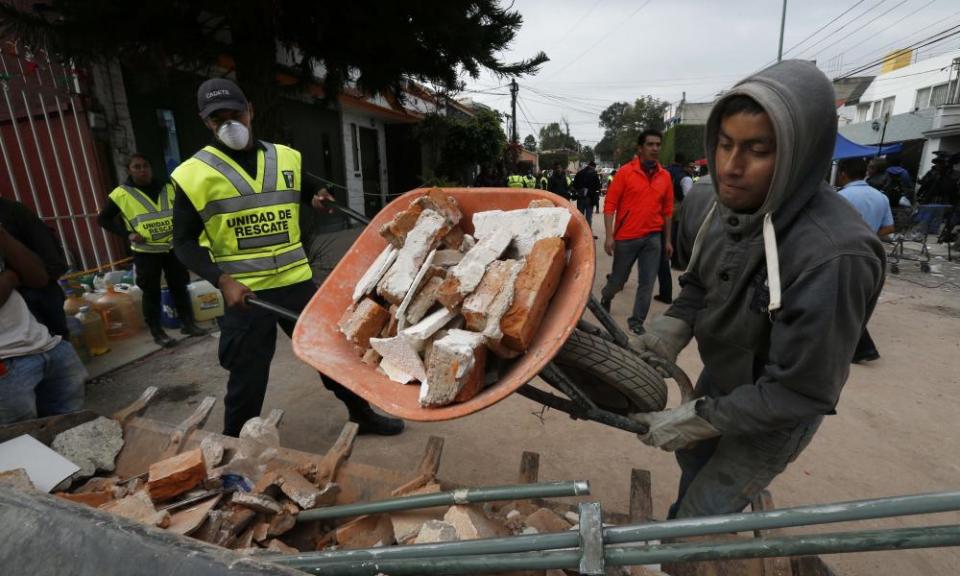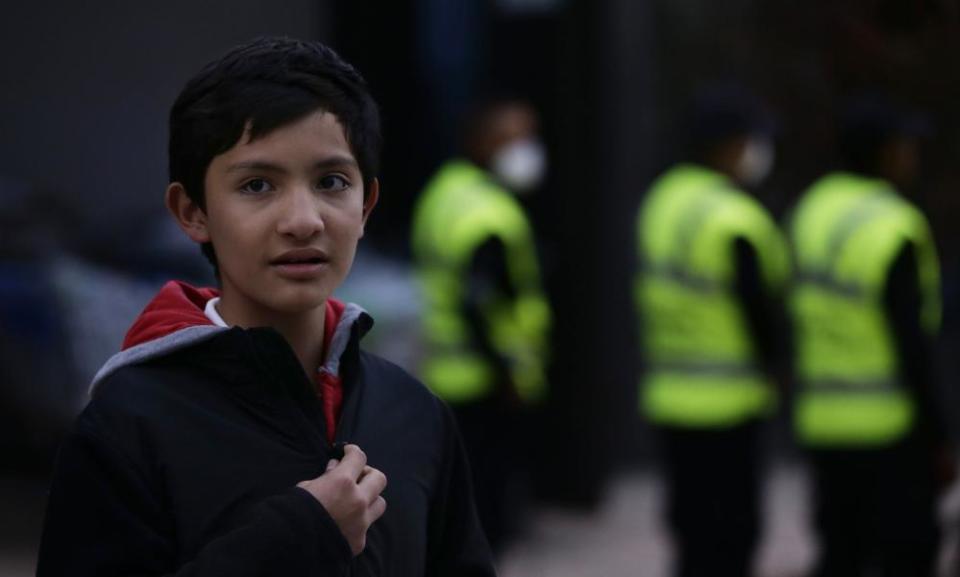'They were buried': hope for children dims amid rubble of Mexico City school

When Silverio Pérez reached the ruined school, he could still hear the screams coming from the children trapped beneath the shattered concrete.
Dozens of people – students and teachers – were still inside the Enrique Rebsámen school when Tuesday’s magnitude-7.1 earthquake rocked Mexico City, reducing the three-storey building to mound of rubble and twisted metal.
Like many other neighbours, Pérez, a lawyer, rushed to the scene and started digging at the wreckage with his bare hands. “I heard kids crying when I got there and saw them hurt. Badly,” said Pérez, bleary-eyed and disheveled after working through the night.
At first the improvised rescue team thought they would be able to free the trapped children; they brought in hoses to pass them water and milk.
“But they couldn’t be reached,” said Pérez. “They were buried.”
The tragedy at the Enrique Rebsámen school bore witness to the scale of the destruction unleashed by the quake. Mexico’s president, Enrique Peña Nieto, visited the school on Tuesday night, but he delivered bad news: 20 children were dead, along with two staff members. Another 30 people were missing.
Two children were dragged out from the ruined primary school, which draws its pupils from Mexico’s upper-middle class.
On Wednesday morning, rumours spread that a teacher and two students had sent text messages from within the rubble, and local television reported that rescuers had spotted a young girl trapped in the building who had moved her hand when they called out to her.
Amid the uncertainty, parents clung to hope that their children had survived.
“They keep pulling kids out, but we know nothing of my daughter,” Adriana D’Fargo told Reuters. She had been waiting for hours for news of her seven-year-old.
But some rescuers were doubtful that any more survivors could emerge from the rubble.
“People are saying these children are alive, but that’s unlikely,” said one Mexican government employee working on the rescue. “It’s dangerous in there. We’re advancing little by little, rock by rock.”
The Mexico City earthquake struck on 19 September – the same day a huge tremor wrecked the national capital in 1985, claiming an estimated 10,000 lives. “Another lethal 19-S,” noted the newspaper Milenio. “Another cursed S-19,” read the headline on El Economista. Others were more optimistic, with Reforma running the headline: “Solidarity emerges.”
After the 1985 quake, Mexican authorities were widely criticised for responding slowly to a national disaster; this time again, many in Mexico City felt that they had been left to fend for themselves.
At the noisy police barricade outside the school, a steady stream of volunteers arrived in work clothes and hard hats, carrying picks and shovels and pushing wheelbarrows. Neighbours came carting jugs of water, trays of tortas (thick sandwiches) and boxes of bananas to refresh the rescuers. Physicians showed up, too.

All were sent to another collapsed building in the area. Several hundred soldiers and civil protection crew members were already picking through the rubble of the school, along with panicked parents and good Samaritans.
“Classes were cancelled so we came to help,” said David Macillas, a student at the Autonomous University of Mexico, who arrived with a full toolkit. The night before, he and a pair of classmates had ventured out to aid in the relief effort – along with thousands of others. “There were already too many people everywhere we went,” Macillas said.
The earthquake inflicted a surprising amount of damage in affluent areas, where buildings are usually sturdier. The Enrique Rebsámen school stood in a solidly middle-class area, with tidy streets, boulevards and American chain stores.
Buildings in many parts of Mexico City – founded by the Aztecs on a lake in the central part of the country, then plundered by the Spanish in 1519 and subsequently drained – swayed violently during earthquakes.
“Mexico City is like jelly,” said Eduardo Corona, a radio operator with civil protection.
Building codes and construction practices have improved since 1985, along with earthquake preparedness. There was a drill just two hours before the Tuesday earthquake rocked the city, though some thought citizens were becoming complacent and have acted nonchalantly.
“Maybe the 1985 earthquake was stronger. But this felt even stronger” as the epicentre was closer to Mexico City, said Corona, a musician who moonlights as a civil protection volunteer. “People are a little more prepared. Communications are better. We have more rescue groups.
“But this earthquake was so strong. No one believed this could happen.”
Authorities at the school put out an urgent call for oxygen tanks, industrial tape, but also mirrors – which would be used to see under the rubble.
Every once in a while, there were calls for silence, and a hush would fall over the site, as rescuers hoped to hear cries for help from anyone still trapped inside. After a pause, however, the grim task of picking through the ruins resumed.
“At this point, we’re clearing out rubble to retrieve the bodies,” said Isaias Garrido, a rescue worker taking a smoke break away from the site. “There probably aren’t any survivors.”

 Yahoo News
Yahoo News 